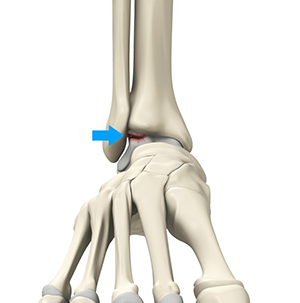OCD Ankle Surgery: Osteochondritis Dissecans

Dr. Kennedy is a world renowned expert in this condition and current co-president of the International Congress of Cartilage Repair of the Ankle (ICCRA) and a part of the International Cartilage Regeneration and Joint Preservation Society (ICRS). He and his team have been responsible for cutting edge and innovative treatments for osteochondral lesions of the ankle and have published more than any other department in this area.
What are Osteochondral Ankle Injuries?
The ankle joint is formed by the articulation of the end of the tibia and fibula (shinbones) with the talus (heel bone). Osteochondral injuries, also called osteochondritis dissecans in adolescents, are injuries to the talus bone. It is characterized by damage to the bone as well as the cartilage covering it. Sometimes, the lower end of the tibia or shinbone may also be affected.
What are the Causes of Osteochondral Ankle Injuries?
Osteochondral injuries are most often caused by trauma to the ankle joint, such as with ankle sprains. Some cases may not have any previous history of ankle injury and may be caused by local osteonecrosis or a metabolic defect.
What are the Symptoms of Osteochondral Ankle Injuries?
The symptoms of osteochondral ankle injuries include:
- Localized pain of the ankle joint
- Tenderness and swelling of the ankle joint
- Difficulty in weight-bearing
- Locking of the ankle
How are Osteochondral Injuries of the Ankle Diagnosed?
Osteochondral injuries are diagnosed by a physical examination, and MRI scan.
What are the Treatment Options for Osteochondral Ankle Injuries?
Nonsurgical or surgical treatment may be recommended for the management of osteochondral injuries of the ankle joint.
Nonsurgical treatment:
- Rarely effective but certain lesions may respond to biologic injections such as PRP.
Dr. Kennedy's Articles Platelet-Rich Plasma and Concentrated Bone Marrow Aspirate in Surgical Treatment for Osteochondral Lesions of the Talus
Dr. Kennedy's Articles Conservative Management and Biological Treatment Strategies: Proceedings of the International Consensus Meeting on Cartilage Repair of the Ankle
Dr. Kennedy's Articles Biologic Adjuvants for the Management of Osteochondral Lesions of the Talus
Surgical treatments:
- Lesion is <1cm in diameter: Biocartilage/ Bone Marrow Stimulation
- Lesion is >1cm in diameter: osteochondral autograft transfer system (OATS) or with grafting from the knee
- For people under the age of 18 years: Trapdoor Procedure
Dr. Kennedy's Articles
- Current concepts in the diagnosis and treatment of osteochondral lesions of the ankle
- Critical defect size for osteochondral lesions of the talus: letter to the editor
- Osteochondral lesions of the talus: aspects of current management
- Osteochondral lesions of the talus: a current concepts review and evidence-based treatment paradigm
- Scaffold-Based Therapies: Proceedings of the International Consensus Meeting on Cartilage Repair of the Ankle
- Lesion Size Measured on MRI Does Not Accurately Reflect Arthroscopic Measurement in Talar Osteochondral Lesions
- Diagnosis and treatment of osteochondral lesions of the ankle: current concepts
- Osteochondral Defects of the Talus: Current Management Dilemmas
- Current management of talar osteochondral lesions
- Post-treatment Follow-up, Imaging, and Outcome Scores: Proceedings of the International Consensus Meeting on Cartilage Repair of the Ankle
Osteochondral Lesion of the Foot (OCL)
We also have a dedicated page for Osteochondral Lesion of the Foot (OCL) injuries.


















